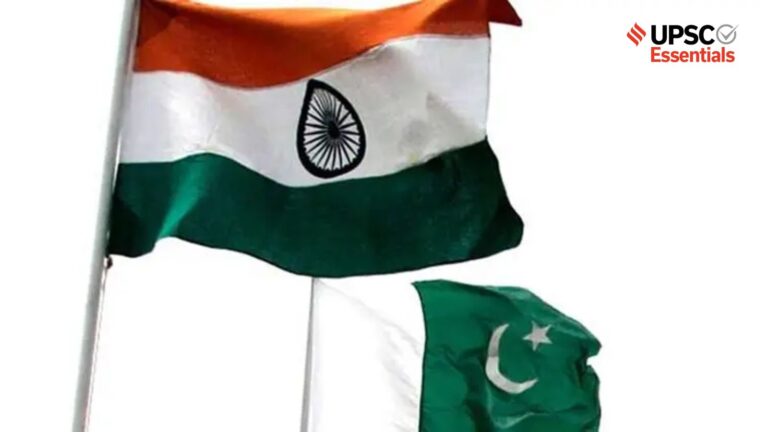— Matthew Joseph C.
(Indian Express We have launched a new series of articles for UPSC aspirants, written by experienced writers and knowledgeable scholars on a range of issues and concepts across History, Politics, International Relations, Arts, Cultural Heritage, Environment, Geography, Science and Technology and more. Read and think with our experts to enhance your chances of passing the coveted UPSC CSE. In our next article, Matthew Joseph C., South Asia expert examines the rise of regionalism in South Asia: This is the second and final part of a series of articles on regionalism in India and South Asia, focusing on India-Pakistan relations, China’s growing involvement in South Asia, and India’s cold shoulder towards SAARC.
The deep-rooted rivalry between India and Pakistan is the main reason for the lack of progress in regional cooperation in South Asia under the banner of the South Asian Association for Regional Cooperation (SAARC). Though the smaller countries in the region feel that SAARC is beneficial to them, they are not individually or collectively in a position to take SAARC forward as an organisation.
Considering its size and capabilities, India has played its role as a responsible member of SAARC, but this was not appreciated by Pakistan, on the contrary, Pakistan has always tried to use the SAARC platform to counter India in various ways.
SAARC dysfunction and Pakistan’s deliberate attempts to exploit it Platform for India New Delhi has been forced to seek ways and means to circumvent Islamabad’s schemes.

To this end, India has experimented with sub-regional cooperation within and outside the region (with neighbouring countries). India’s engagement in the Bay of Bengal Initiative for Multisectoral Technical and Economic Cooperation (BIMSTEC), Indian Ocean Rim Association (IORA), Mekong-Ganges Cooperation (MGC) and Bangladesh, Bhutan, India, Nepal (BBIN) Initiative activities are examples of this strategy.
India’s Natural Advantages in South Asia
India’s distance from the SAARC organisation has boosted regional cooperation in South Asia and helped India re-establish its long-standing ties with countries and communities in the Indo-Pacific and Indian Ocean basins.

Smaller countries in the region have benefited greatly from the expansion of intra-regional cooperation. It is interesting to note that the sluggish growth of regionalism in South Asia has indirectly boosted intra-regional cooperation in the region as well as extra-regional cooperation with the Indo-Pacific.
India’s natural advantage in South Asia is All countries in the region except Pakistan. Islamabad’s position in this regard is not based on a realistic understanding of the situation on the ground.
Rather, Pakistan’s negative stance towards India in South Asia and beyond is based on ideological reasons. The idea of regional cooperation, though beneficial, may not be acceptable to Pakistan due to ideological differences. This includes Pakistan’s attempts to rally smaller South Asian countries against India and bring China into the South Asian arena.
China’s expanding footprint in the region
China became an observer in SAARC in 2005. At the 2005 SAARC summit in Dhaka, Pakistan, Nepal and Bangladesh supported China’s observer status, while India, Bhutan, Maldives and Sri Lanka opposed it.
In addition to China, the United States, the European Union, Australia, Iran, Mauritius, Japan, South Korea and Myanmar have observer status in SAARC. China has used its observer status in the SAARC framework to justify its increased engagement in the region.
China has fairly strong ties with Nepal, Bangladesh and the Maldives, and is working to further deepen ties with Bhutan. China also has “all-weather relations” with Pakistan.
China’s growing engagement in South Asia is something India is cautious about. As Beijing’s engagement in South Asia has increased, its relations with India have deteriorated. The Doklam crisis in 2017 and the Galwan skirmish in 2020 are examples of the deterioration of India-China relations.
China’s expanding footprint in South Asia therefore directly challenges India’s inherent dominance in the region.
India needs to actively engage with its neighbours
Hence, one of the main reasons for India to leave SAARC for the time being can be explained as follows: India believes that strong ties between Pakistan and China and the attraction of smaller countries in the region towards China may lead to India’s isolation in the region in the long run.
In that context, India’s cold attitude towards SAARC and increased engagement in other platforms such as BIMSTEC, IORA, MGC and BBIN are justified given their geopolitical sensitivities.
However, it may not be in India’s interest to completely distance itself from South Asian regional platforms. India’s indifference to South Asian regionalism does not prevent China from developing ties with other countries in the region.
On the contrary, it will help China penetrate further into South Asia. Hence, instead of distancing itself from regional platforms like SAARC, India needs to actively engage with its neighbours apart from maintaining its presence in BIMSTEC and other platforms.
South Asia is India’s natural homeland and all other countries in the region are culturally and otherwise connected to India. Hence, greater engagement with its neighbours will improve India’s relations with its neighbours and strengthen the positive aspects of regionalism in South Asia. It will also help check China’s growing involvement in the region.
Posts Read Questions
Discuss the obstacles that have affected SAARC’s efforts towards regional cooperation.
India’s active engagement with its neighbours will strengthen the positive aspects of regionalism in South Asia. Comments.
Discuss ways and means to further strengthen cooperation among South Asian member states.
China’s observer status in SAARC has legitimized its increased engagement in the region. Comments.
(Matthew Joseph C. is Professor at the MMAJ Academy of International Studies, Jamia Millia Islamia, New Delhi.)
subscribe UPSC Newsletter Stay up to date with breaking news from the past week.
Stay up to date Latest UPSC Articles our Telegram Channel – IndianExpress UPSC Huband follow us Instagram and X.


